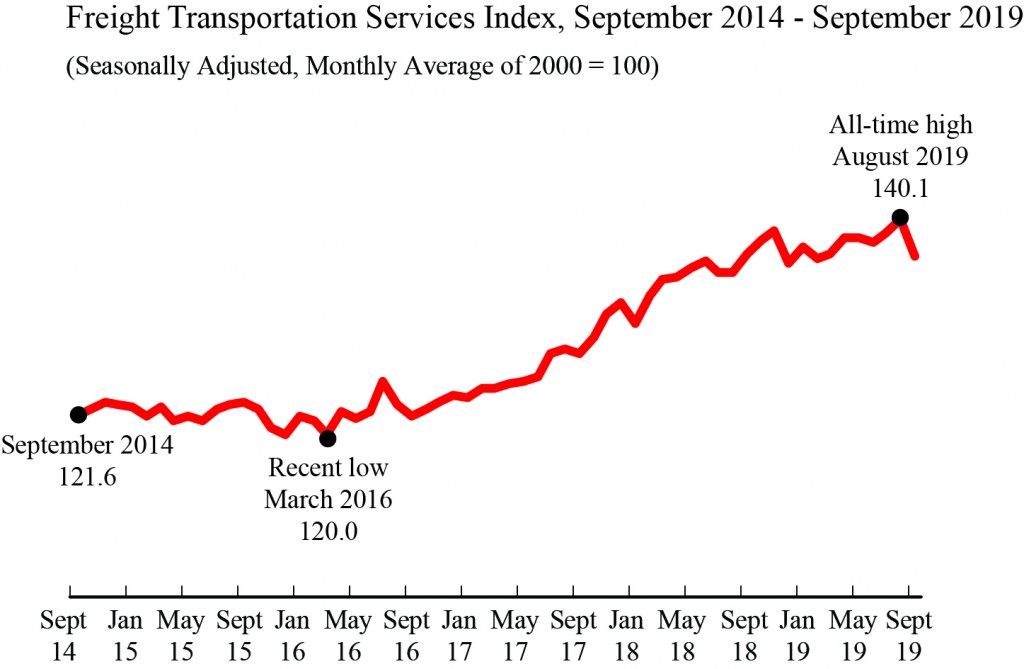
The Freight Transportation Services Index (TSI), which is based on the amount of freight carried by the for-hire transportation industry, fell 2.5% in September after reaching after reaching a new all-time high in August, according to the U.S. Department of Transportation’s Bureau of Transportation Statistics’ (BTS). From September 2018 to September 2019, the index fell 0.1% compared to a rise of 7.2% from September 2017 to September 2018 (Tables 1, 2, and 2A).

The level of for-hire freight shipments in September measured by the Freight TSI (136.6) was 2.5% below the all-time high level of 140.1 in August 2019 (Table 2A). BTS’ TSI records begin in 2000. See historical TSI data.
The August index was revised to 140.1 from 140.6 in last month’s release but still remains an all-time high. Monthly numbers for January through July were revised up slightly.
The Freight TSI measures the month-to-month changes in for-hire freight shipments by mode of transportation in tons and ton-miles, which are combined into one index. The index measures the output of the for-hire freight transportation industry and consists of data from for-hire trucking, rail, inland waterways, pipelines and air freight. The TSI is seasonally-adjusted to remove regular seasons from month-to-month comparisons.
Analysis: The Freight TSI September decrease of 2.5% was broad based, driven by significant declines in water, rail carloads, trucking, pipeline and air freight, while rail intermodal increased modestly. The TSI decline took place against a background of decline in other indicators.
The Federal Reserve Board Industrial Production Index declined 0.4% in September reflecting decreases in mining and manufacturing and an increase in utilities. Housing starts declined by 9.4%. The Institute for Supply Management Manufacturing index decreased 1.3 points to 47.8, indicating contraction in manufacturing
Trend: The Freight Index’s 2.5% decline in September, from a record high in August, was the largest one month Freight TSI decline since January 2012, and left the index at its lowest level since February 2019. However, it remained above any level it had reached before the high of September 2018 and in all but three months prior to January 2019. In effect, the Freight TSI rose 14% from 120 in March 2016 to a level of 136.8 in September 2018, but has been essentially stable (declining by 0.1 %) since then.
The 0.9% decrease in the third quarter of 2019, following two quarters of growth, and a quarter of decline in the fourth quarter of 2018. It was only the third quarterly decline since the second quarter of 2015, but it was the largest quarterly decline since the fourth quarter of 2015. The index has increased in 10 of 12 quarters since the fourth quarter of 2016. The September index was 44.1% above the April 2009 low during the most recent recession. For additional historical data, go to TSI data.
Index highs and lows: For-hire freight shipments in September 2019 (136.6) were 44.1% higher than the low in April 2009 during the recession (94.8). The September 2019 level was 2.5% below the historic peak reached in August 2019 (140.1).
Year-to-date: For-hire freight shipments measured by the index were up 0.4% in September compared to the end of 2018 (Table 3).
Long-term trend: For-hire freight shipments are up 12.3% in the five years from September 2014 and are up 37.1% in the 10 years from September 2009 (Table 5).
Same month of previous year: September 2019 for-hire freight shipments were down 0.1% from September 2018 (Tables 4, 5).
3rd quarter changes: The freight TSI fell 0.9% in the 3rd quarter after rising 0.7% in each of the first two quarters of 2019. The third-quarter decline was the first quarterly decrease since the fourth quarter of 2018 and the second quarterly decrease since the third quarter of 2016 (Table 10).
The TSI has three seasonally adjusted indexes that measure changes from the monthly average of the base year of 2000. The three indexes are freight shipments, passenger travel and a combined measure that merges the freight and passenger indexes. See Seasonally-Adjusted Transportation Data for numbers for individual modes. TSI includes data from 2000 to the present. Release of the October 2019 index is scheduled for Dec. 11.
Passenger Index: The TSI for passengers fell 0.6% in September from its August level (Table 6). The Passenger TSI September 2019 level of 133.3 was 4.1% above the September 2018 level (Table 7). The index is up 11.5% in five years and up 22.4% in 10 years (Table 5). The passenger TSI measures the month-to-month changes in travel that involves the services of the for-hire passenger transportation sector. The seasonally adjusted index consists of data from air, local transit and intercity rail.
Combined Index: The combined freight and passenger TSI fell 1.8% in September from its August level (Table 8). The combined TSI September 2019 level of 135.1 was 1.4% above the September 2018 level (Table 9). The combined index is up 12.1% in five years and up 32.2% in 10 years (Table 5). The combined TSI merges the freight and passenger indexes into a single index.
Revisions: Monthly data has changed from previous releases due to the use of concurrent seasonal analysis, which results in seasonal analysis factors changing as each month’s data are added.
BTS research has shown a clear relationship between economic cycles and the Freight and Passenger Transportation Services Indexes. See a study of this relationship using smoothed and detrended TSI data. Researchers who wish to compare TSI over time with other economic indicators, can use the FRED database, which includes freight, passenger and combined TSI, and which makes it possible to easily graph TSI alongside the other series in that database.








